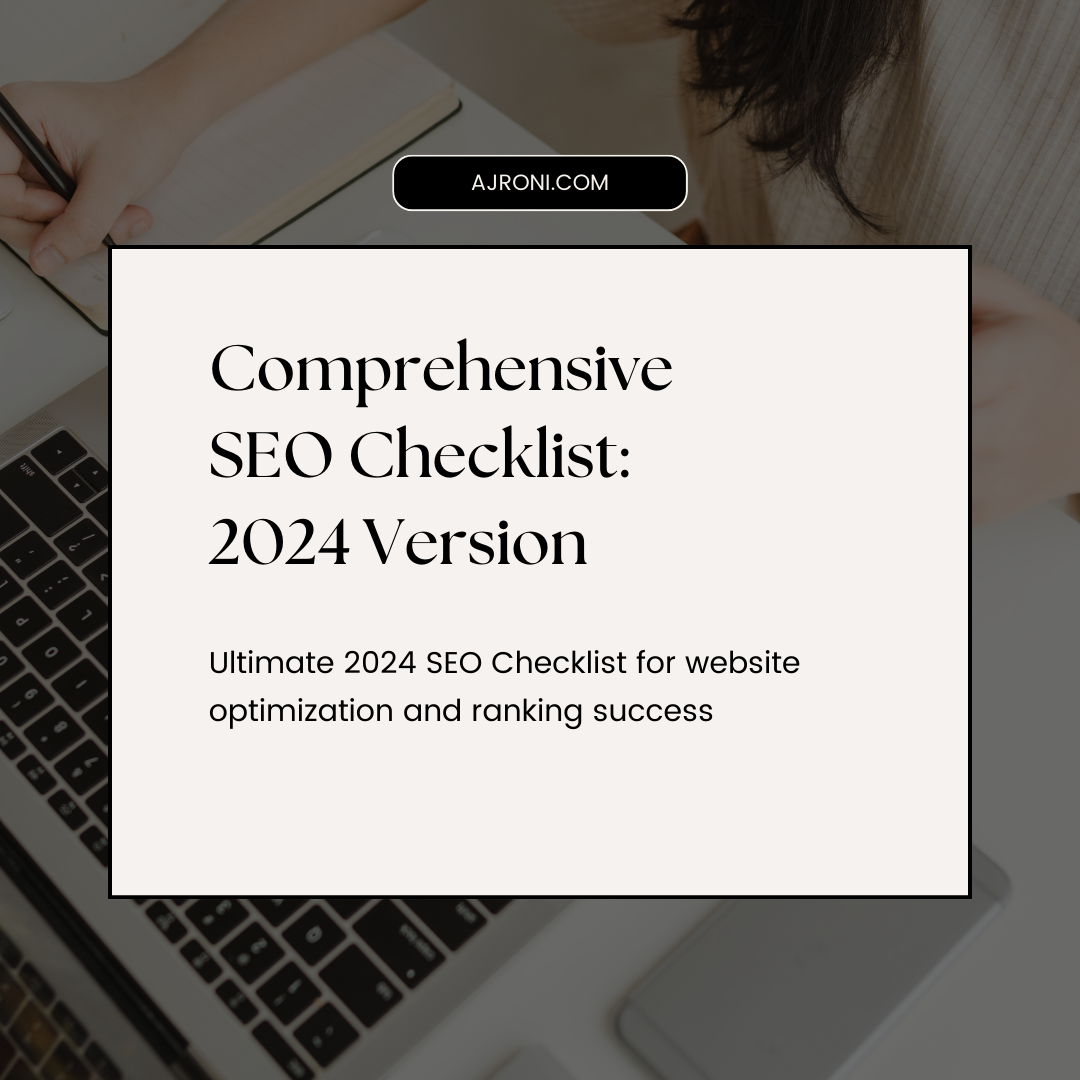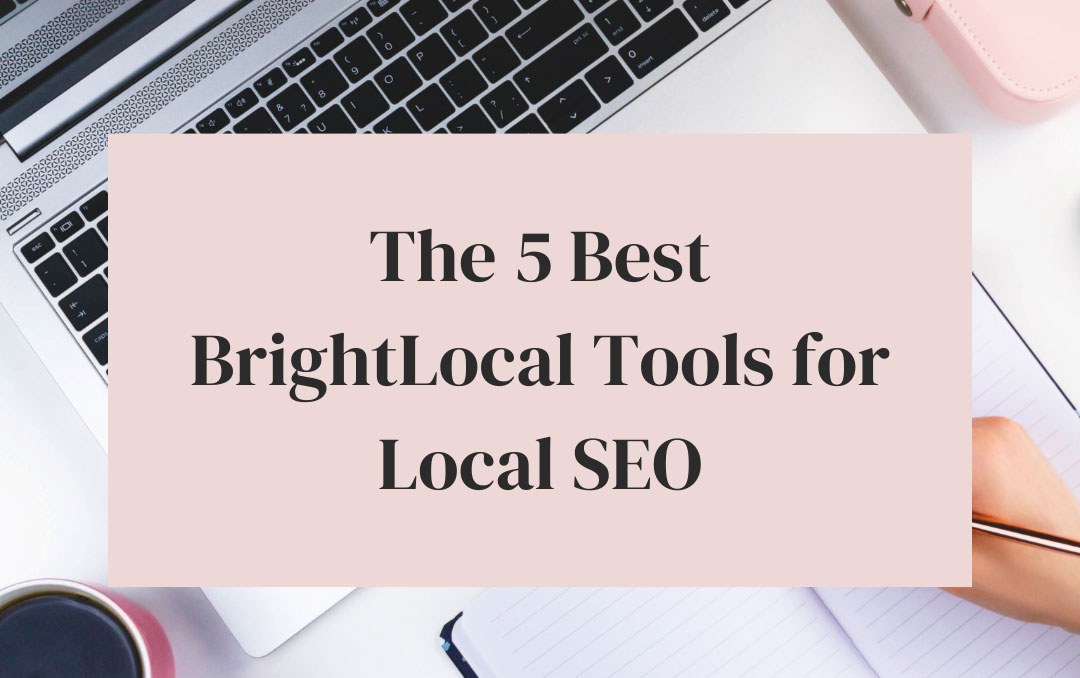Search Engine Optimization (SEO) is the backbone of digital visibility. As we step into 2024, the landscape of SEO continues to evolve, adapting to new algorithms, user behaviors, and technological advancements. Staying ahead in SEO means constantly updating your strategies to align with these changes. This guide presents a meticulously crafted SEO checklist for 2024, designed to ensure your website not only keeps pace with these evolutions but thrives amidst them.
SEO Basics Checklist
1. Set Up Google Search Console and Bing Webmaster Tools
Google Search Console (GSC) and Bing Webmaster Tools are essential for monitoring your site's performance in search results. They offer insights into search queries, site errors, and indexing issues, providing a solid foundation for your SEO efforts.
-
Google Search Console: Set up GSC to track your site's performance on Google. It helps identify crawl errors, understand Google's indexing of your site, and optimize your visibility.
-
Bing Webmaster Tools: Don't overlook Bing. Set up Bing Webmaster Tools for similar insights on Bing search engine.
Pro Tip: Regularly check both tools for any alerts or issues that could impact your site's search performance.
2. Set Up Google Analytics
Google Analytics provides comprehensive data on your website traffic, user behavior, and conversion metrics. It's invaluable for understanding how visitors interact with your site and identifying areas for improvement.
-
Google Analytics Setup: Follow this Google Analytics Guide to install and configure your account. Connect it with GSC for a more integrated view of your SEO data.
3. Install and Configure an SEO Plugin (For WordPress Users)
If your site is on WordPress, an SEO plugin can significantly simplify the optimization process. Plugins like Yoast SEO , Rank Math, and Semrush's SEO Writing Assistant offer tools for optimizing meta tags, generating sitemaps, and improving content readability.
-
Yoast SEO: Yoast is a comprehensive SEO plugin that guides you through optimizing your content and technical SEO aspects.
-
Rank Math: Rank Math offers intuitive features to improve your site's SEO, including built-in suggestions and analytics.
Pro Tip: Regularly update your SEO plugin to leverage the latest features and ensure compatibility with other site elements.
4. Create and Submit a Sitemap
A sitemap is crucial for search engines to crawl and index your website effectively. It lists all your website pages, making it easier for search engines to discover and rank your content.
-
Create a Sitemap: Use tools like XML Sitemaps to generate a sitemap for your site.
-
Submit Your Sitemap : Upload your sitemap to GSC and Bing Webmaster Tools to ensure search engines can easily access and index your pages.
5. Create a Robots.txt File
The robots.txt file tells search engines which pages or sections of your site should not be crawled. This helps prevent indexing of duplicate or irrelevant pages.
-
Robots.txt Guide: Learn how to create and configure a robots.txt file for your website.
6. Check Search Console for Manual Actions
Manual actions are Google's way of penalizing sites that violate its guidelines. Regularly check GSC for any manual actions against your site, as these can severely impact your site's visibility in search results.
-
Manual Actions: Understand and resolve manual actions to regain search visibility.
7. Ensure Google Can Index Your Website
Making sure your website is indexable is fundamental. Use GSC to verify that Google can crawl and index your site without issues.
-
Indexability Check: Use the URL Inspection Tool in GSC to check the index status of your pages.
Pro Tip: Regularly review your index status, especially after making significant site updates or changes.
Keyword Research Checklist
Keyword research is the cornerstone of any successful SEO strategy, guiding your content creation and optimization efforts to meet the needs of your target audience. This checklist will help you identify, analyze, and select the most effective keywords to drive relevant traffic to your website.
8. Identify Your Competitors
Start by identifying who your SEO competitors are. These might not always be your direct business competitors but are websites that rank well for keywords you want to target.
-
Competitor Analysis Tools: Use tools like Semrush's Competitive Research Toolkit to identify your main SEO competitors and understand their keyword strategy.
9. Find Your Main 'Money' Keywords
'Money' keywords are those that are most likely to convert visitors into customers. They typically have commercial or transactional intent.
-
Keyword Discovery: Utilize keyword research tools like Google Keyword Planner or Semrush's Keyword Magic Tool to find high-value keywords relevant to your business.
10. Find Long-Tail Keyword Variations
Long-tail keywords are longer and more specific keyword phrases. They often have lower search volumes but can drive more targeted traffic and have higher conversion rates.
-
Long-Tail Discovery: Use AnswerThePublic or the “Questions” filter in Semrush's Keyword Magic Tool to find long-tail questions and phrases related to your main keywords.
11. Create a Keyword Map
A keyword map assigns your identified keywords to specific pages on your site. This helps ensure that each page targets a unique set of keywords.
-
Mapping Process : Organize your keywords by relevance and search intent, then assign them to the most appropriate pages on your site. Tools like Semrush's Keyword Manager can facilitate this process.
12. Analyze the Intent of Pages That Rank
Understanding the intent behind a search query is crucial. Google aims to rank pages that best satisfy the user's intent, whether it's to find information, make a purchase, or find a specific website.
-
Intent Analysis : For each target keyword, analyze the top-ranking pages to understand the type of content that ranks well (e.g., product pages, blog posts, tutorials) and tailor your content accordingly.
13. Identify Questions People Ask
Questions are a goldmine for content ideas and can help you target long-tail keywords. Answering these questions can improve your visibility in search results, especially in featured snippets.
-
Question Discovery: Use tools like AlsoAsked.com to find common questions related to your keywords. Incorporate these questions and their answers into your content.
14. Understand Your Ranking Difficulty
Some keywords are highly competitive and difficult to rank for, especially for new or low-authority sites. Assessing the ranking difficulty can help you prioritize your efforts on keywords where you have a realistic chance of achieving high rankings.
-
Difficulty Assessment : Use the “Keyword Difficulty” score available in keyword research tools like Semrush or Ahrefs to gauge how hard it would be to rank for each of your target keywords.
Technical SEO Checklist
Technical SEO is the foundation that allows search engines to crawl, index, and render your website effectively. A solid technical SEO setup enhances user experience and helps search engines understand and prioritize your content. Here's what you need to focus on in 2024:
15. Ensure Use of HTTPS
Secure your website with HTTPS to protect the integrity and confidentiality of data between your user's browser and your site. Google has confirmed HTTPS as a ranking signal.
-
HTTPS Setup: Ensure your site has a valid SSL certificate. Let's Encrypt offers free certificates.
16. Check for Duplicate Versions of Your Site in Google's Index
Google should only index one version of your site. Variations include www vs. non- www, http vs. https, and trailing slashes. Choose one version as the canonical and redirect all others to it.
-
Canonicalization Guide: Learn more about setting up the preferred domain in Google's documentation.
17. Find and Fix Crawl Errors
Crawl errors can prevent search engines from accessing parts of your site, which can negatively impact your rankings. Use Google Search Console to identify and fix any crawl errors.
-
Crawl Errors: Monitor the “Coverage” section in GSC for errors and address them promptly.
18. Improve Your Site Speed
Site speed is a critical ranking factor and a key component of user experience. Use tools like Google's PageSpeed Insights to analyze and improve your site's loading times.
-
Optimization Tips: Leverage caching, optimize images, and minimize JavaScript and CSS for faster loading times.
19. Fix Broken Internal and Outbound Links
Broken links lead to poor user experience and can harm your site's credibility. Regularly audit your site to find and fix broken links.
-
Link Checker Tool: Use Broken Link Checker or similar tools to identify and repair broken links.
20. Find and Fix HTTP Links on HTTPS Pages
Ensure all internal links on HTTPS pages point to HTTPS URLs to avoid mixed content issues, which can affect site security and user experience.
-
Mixed Content Guide: Mozilla's documentation offers insights on fixing mixed content issues.
21. Ensure Your Website Is Mobile-Friendly
With Google's mobile-first indexing, your site must perform well on mobile devices. Use Google's Mobile-Friendly Test tool to check your site's mobile usability.
-
Mobile-Friendly Test: Test your pages with Google's Mobile-Friendly Test .
22. Use an SEO-Friendly URL Structure
A clear and descriptive URL structure is more understandable for both users and search engines. Keep URLs short, use hyphens to separate words, and include keywords where relevant.
-
URL Structure Best Practices: Here's a guide by Moz on creating SEO-friendly URLs.
23. Add Structured Data
Structured data helps search engines understand your content and enhances your search listings with rich snippets, which can improve click-through rates.
-
Schema Markup: Use Schema.org vocabulary and Google's Structured Data Testing Tool to implement and test your structured data.
24. Check Your Site's Crawl Depth
Ensure important pages are no more than three clicks away from the homepage. A shallow site architecture helps both users and search engines find content more efficiently.
-
Site Architecture Optimization: This guide from Search Engine Journal offers strategies for optimizing site architecture.
25. Check Temporary 302 Redirects
Temporary 302 redirects should be used sparingly and only for short-term changes. For permanent redirects, use 301s to pass link equity to the new URL.
-
Redirects Guide: Understand the differences and SEO implications of 301 vs. 302 redirects .
26. Find and Fix Redirect Chains and Loops
Redirect chains and loops can confuse search engines and degrade user experience. Simplify your redirect strategy by ensuring direct redirection from the original to the final destination URL.
-
Solving Redirect Issues: Ahrefs offers a tutorial on identifying and fixing redirect chains and loops.
Content & On-Page SEO Checklist
Content and on-page SEO are crucial for ensuring your website's pages are optimized for both search engines and users. This part of SEO focuses on making your site's content relevant, authoritative, and user-friendly. Here's how to ensure your content and on-page elements are fully optimized:
27. Find and Fix Duplicate, Missing, and Truncated Title Tags
Title tags are critical for SEO and user experience. They should be unique for each page, accurately describe the page content, and be within 60 characters to avoid truncation in search results.
-
Title Tag Optimization: Use Moz's Title Tag Guide for best practices on crafting effective title tags.
28. Find and Fix Duplicate and Missing Meta Descriptions
Meta descriptions, while not a ranking factor, influence click-through rates from search results. Each page should have a unique meta description that acts as an ad for your content, ideally between 150-160 characters.
-
Meta Description Best Practices: HubSpot's Guide provides insights on writing compelling meta descriptions.
29. Find and Fix Multiple H1 Tags
Each page should have a single H1 tag that summarizes the page content. Multiple H1s can confuse search engines and dilute the page's focus.
-
H1 Tag Optimization: Search Engine Journal's article on H1 tags explains their importance and how to use them effectively.
30. Improve Title Tags, Meta Tags, and Page Content
Ensure your title tags, meta descriptions, and content are optimized for your target keywords while being engaging for readers. Include primary and secondary keywords naturally in your content.
-
On-Page SEO Guide: Backlinko's On-Page SEO Guide offers comprehensive tips on optimizing these elements.
31. Audit Your Site's Existing Content
Regularly review your content to ensure it's up-to-date, relevant, and provides value to your audience. Update, merge, or delete content as necessary to keep your site fresh and authoritative.
-
Content Audit Steps: Semrush's Content Audit Tool can help streamline this process.
32. Ensure Images Use Alt Text
Alt text helps search engines understand the content of images and improves accessibility for users with visual impairments. Ensure all images on your site have descriptive, keyword-rich alt text.
-
Alt Text Best Practices: W3C's guide on alt text provides a decision tree for writing effective descriptions.
33. Improve Internal Linking
Internal linking helps distribute page authority throughout your site and improves navigation for users. Use descriptive anchor text and link to relevant content within your site.
-
Internal Linking Guide: Yoast's Internal Linking SEO Guide explains how to strategically use internal links.
34. Find and Fix Keyword Cannibalization Issues
Keyword cannibalization occurs when multiple pages target the same keyword, potentially diluting the ranking strength of each page. Consolidate or differentiate content to address this issue.
-
Keyword Cannibalization Solutions: Ahrefs' guide to identifying and fixing keyword cannibalization can help.
35. Find and Fix Orphan Pages
Orphan pages are not linked from any other page on your site, making them hard for search engines and users to find. Ensure every page is accessible through at least one internal link.
-
Orphan Pages Identification: Use tools like Screaming Frog SEO Spider to find and fix orphan pages.
36. Ensure Your Site's Content Is Up to Date
Outdated content can harm your site's credibility and rankings. Regularly update your content to reflect the latest information, trends, and data in your industry.
-
Content Updating Guide: This guide from Moz on conducting a content audit includes tips for updating old content.
Link Building & Off-Page SEO Checklist
Link building and off-page SEO are crucial for improving your site's authority and visibility in search engine results. These strategies focus on increasing the number and quality of inbound links to your website, signaling to search engines that your site is a valuable resource. Here's how to enhance your off-page SEO:
37. Analyze Your Competitors' Link Profiles
Understanding your competitors' backlink profiles can reveal opportunities for your own link-building efforts. Identify where their links are coming from and target similar sites for your outreach.
-
Competitor Analysis Tools: Use tools like Semrush's Backlink Analytics to analyze competitors' backlink profiles.
38. Conduct a Link Intersect Analysis
Find websites that link to several of your competitors but not to you. These sites are more likely to be interested in linking to your content if it adds value to their audience.
-
Link Intersect Tool: Ahrefs' Link Intersect Tool can help you discover these opportunities.
39. Turn Unlinked Mentions Into Links
Search for mentions of your brand, products, or services that aren't linked back to your site. Reach out to these sites and kindly ask them to add a link to the relevant page on your website.
-
Brand Mention Tools: Tools like Mention or Google Alerts can help you track unlinked mentions.
40. Find New Link Building Opportunities
Always be on the lookout for new link-building opportunities. This can include guest blogging, industry forums, directories, and more. Focus on high-quality links that will drive traffic and improve your site's authority.
-
Guest Blogging: Identify top blogs in your industry and propose high-quality content that includes a link back to your site.
-
Industry Forums and Directories: Participate in relevant forums and ensure your business is listed in reputable directories.
Pro Tips for Effective Link Building:
-
Quality Over Quantity : Focus on acquiring high-quality links from reputable sites within your industry. A few high-authority links can be more beneficial than many low-quality links.
-
Build Relationships : Networking and building relationships with other webmasters, bloggers, and influencers in your industry can lead to more natural link-building opportunities.
-
Create Link-Worthy Content : The best way to earn links is by creating valuable, informative, and shareable content that others want to link to. This includes original research, comprehensive guides, infographics, and tools.
-
Monitor Your Backlink Profile : Regularly monitor your backlink profile to identify and disavow any spammy or harmful links that could negatively impact your SEO.
Additional Off-Page SEO Strategies:
-
Social Media Engagement : While social media links are typically nofollow, they can drive traffic and increase brand visibility, indirectly influencing your SEO.
-
Local SEO : For businesses with a physical location, optimizing your Google My Business listing and acquiring local citations can improve your local search visibility.
Local SEO and Google Business Profile
Local SEO is a critical component for businesses that operate on a local level. By optimizing your online presence for local search, you can increase your chances of being found by users searching for products and services in your area. A key element of local SEO is your Google Business Profile (GBP), formerly known as Google My Business.
Set Up and Optimize Google Business Profile
Your Google Business Profile is a free listing that appears in Google Maps and local search results, making it easier for customers to find information about your business.
-
Claim and Verify Your Listing: Start by claiming your GBP listing here . Verification is typically done via postcard, phone, or email.
-
Complete Every Section : Fill out every part of your GBP profile, including business name, address, phone number, website, business hours, categories, and services.
-
Add High-Quality Photos : Businesses with photos receive more requests for directions and clicks through to their websites. Regularly update your photos to keep your profile fresh.
-
Collect and Respond to Reviews : Encourage satisfied customers to leave positive reviews. Respond to all reviews, both positive and negative, in a professional manner.
-
Post Regularly : Use GBP posts to update customers about offers, events, and business news. Regular posts can improve your visibility and engagement.
Additional Local SEO Strategies
-
Optimize for Local Keywords: Include location-based keywords in your website's content, meta tags, and URLs.
-
Build Local Citations : Ensure your business is listed in local directories and citation sites with consistent NAP (Name, Address, Phone Number) information.
-
Create Local Content : Publish content that speaks to local issues, events, or activities to engage your community and attract local search traffic.
Conclusion
SEO is an ever-evolving field, requiring continuous learning and adaptation. The "Comprehensive SEO Checklist: 2024 Version" provides a structured approach to optimizing your website across various dimensions of SEO, including technical aspects, content creation, on-page optimization, link building, and local SEO strategies. By systematically addressing each point on this checklist, you can improve your site's visibility, drive more organic traffic, and achieve your business objectives.
Remember, SEO is not a one-time task but an ongoing process. Regularly auditing your website, keeping abreast of the latest SEO trends, and adapting your strategies accordingly are key to maintaining and improving your search engine rankings over time. With dedication, patience, and a strategic approach, you can build a strong online presence that stands the test of time and algorithm updates.
In the dynamic world of SEO, staying informed, proactive, and adaptable is the key to success. Use this comprehensive checklist as your guide to navigate the complexities of SEO in 2024 and beyond, ensuring your website not only meets the current standards but is also poised for future growth.




